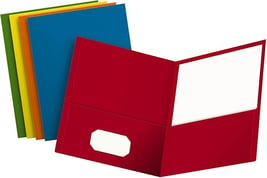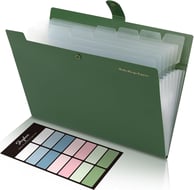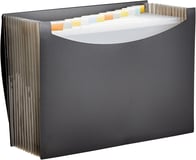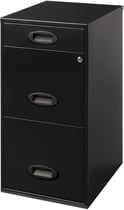The Ultimate Guide to Organizing Your Medical Documents: A Simple, Space-Saving Solution
Feeling overwhelmed by medical paperwork? Simplify your life with these easy tips to organize your health records. From simple folders to traditional filing, find the best system for your medical documents.


Let's face it, medical documents can be a real pain for most of us. And unless we have the superhuman OCD gene that keeps everything tidy and organized, those documents tend to stack up like a Jenga tower, ready to topple over at any moment. And then trying to find that one specific document when we need it most? Forget about it. It's like searching for a needle in a haystack, only the haystack is made of confusing medical jargon and tiny print. So is there a solution instead of just ignoring that growing mound of frustration and intimidation?-- Yes, fear not, I definitely believe there is, And it is a simple and effective solution that I’ve used for years: the bifold folder.
The Bifold Folder: Your New Best Friend
A bifold folder is a small, portable folder that is divided into two sections with a pocket on each side. These folders are also known as school folders or “Pee-Chee folders” for those of us older than 40. This makes it ideal for storing medical documents. What I like to do is to take two folders and label one "Medical Documents" and the other "Bills & EOBs (estimation of benefits)." Then, and this is the most time consuming part, but should only have to be done once, sort through your pile of papers and place them in the appropriate folder.
A Couple Additional Tips for Organizing Your Medical Documents:
File Documents Chronologically: Always file new documents at the front of the folder to keep them in chronological order.
Use Post-it Notes: If you need to remove a document, place a Post-it note where it was to mark the spot. Or you can use a ruler or paperclip or anything else that would be easy to find between papers.
Reasons Bifold Folders Are Nice for Document Organization
Space-Saving: Bifold folders are much smaller than traditional filing cabinets, making them perfect for people with limited space. They can be placed in a drawer, or what I used to do, put them on the shelf with books.
Easy to Use: There's no complicated filing system to learn. Simply place new documents at the front of the folder, and you'll always know where to find them.
Portable: You can easily take your bifold folders with you to the doctor's office or hospital appointments.
Affordable: Bifold folders are inexpensive and readily available at many different kinds of stores.
If you’re like me and like to shop and order online, there are plenty of options on Amazon. I like these particularly because of the different color options.
Another option that uses the same filing concept as the bifold folders, but may appeal to someone wanting more of a traditional filing approach are expanding file folders.
Reasons Expanding File Folders Are Nice for Document Organization
Similar to bifolds: You can designate two of the slots for “Medical Documents” and “Medical Bills/EOBs” like the folders and use them the same way.
Space Saving: Though larger than the regular bifolds, they are still more portable and take up much less space than a traditional filing cabinet.
Increased Sorting Options: If you want slightly more sorting options for your filing system, but don’t want a filing cabinet, the many tabs in the expanding file folders could be your solution. You can assign tabs to individuals in the family or to break down the medical records into more defined categories such as dental, vision, surgical, etc.
Ultimately, I won’t leave it off the table, and it’s the traditional filing cabinet.
Now, this is not a simple, easy solution to organizing medical documents for most people. I see this more as a long-term filing solution when someone has a more established home office space. I found this cabinet on Amazon, and it looks exactly like what I’ve had for over 15 years. I love my little cabinet because I use it for all my home filing needs, not just medical documents. It’s not easily portable, but it’s also not full-sized so when I’ve moved house, it hasn’t been too difficult to relocate.
Over the years, I’ve used each of the filing systems above. If organization is not your game, I definitely recommend starting with the most simple solution. If you want to upgrade your organizational game or simply want something with more options or more permanent, the other filing systems are also good to consider.
Additional Tips to Consider for Organizing Your Medical Documents:
Scan Important Documents: Create digital copies of important documents, such as insurance cards and medical test results, as a backup. I keep these all in a folder on my computer, and the way I have my computer set up, they all automatically save to the cloud so I don’t ever have to worry about losing them if my computer gets damaged or stolen.
Review Your Medical Records Regularly: Make time to review your medical records periodically to ensure that everything is accurate and up-to-date. I actually only do this when we get new insurance cards every year, and then every couple of years I go through and sort out and shred any documents I no longer need like old bills or records I already have digital copies of.
So, consider the simple tips shared above to easily organize your medical documents and reduce stress. And if you want to take the first steps, grab a few bifold folders and start decluttering your life today!
Disclaimer: This article may contain affiliate links. This article is formed from personal experience and opinions of the writer(s). No information in this article may be taken as a substitute for personalized advice from an appropriately licensed healthcare professional.








